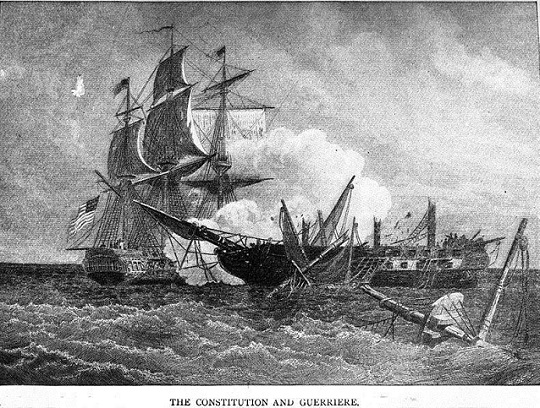Though not strategically significant, the brutal engagement between the American’s USS Constitution and the British Guerriere shot to pieces the aura of the Royal Navy’s invincibility on the high seas.

Our Country in War by Murat Halstead (1898)
Because naval warships took so long to construct, the vessels that fought the War of 1812 were built during the 1790s. America’s embryonic navy, which included the USS Constitution and several other frigates, was fashioned in part from a remarkable species of wood called southern live oak. A dense wood that weighed as much as 75 pounds per cubic foot, live oak was extremely strong and resistant to rot and salt air. Though shipbuilders found it extremely difficult to work with because of its hardness, American designers foresaw huge potential in the wood.
But because most of the live oak stands were located on the swampy coastal islands of Georgia, obtaining the timber was costly, time consuming, and difficult. The first group of cutters from New England fell sick from malaria within days. Those who survived went home. Most of the oxen used to haul the timbers succumbed as well. Enslaved African-Americans, more accustomed to working in dreadful conditions, were brought in from the mainland to help build roads. Eventually, after numerous delays and cost overruns, enough live oak to supply the shipyards made its way up the coast to Boston. The 44-gun USS Constitution was launched on Oct. 21, 1797.
Almost fifteen years later, in August 1812—just a month after the declaration of war—the Constitution sighted the British warship Guerriere about 750 miles east of Boston. Commanding the American vessel was Captain Isaac Hull, the nephew of the disgraced General William Hull, who had only a few days before had ignominiously surrendered Fort Detroit to British General Isaac Brock.
As the ships closed, the Guerriere’s outgunned commander nevertheless pronounced that he would take the Constitution within thirty minutes. The veteran Royal Navy was renowned as the world’s most powerful, while the small American navy consisted of fewer than two dozen ships. British sailors expected to get the best of every engagement they fought.
As the Constitution came within range, Captain Hull ordered his gunners to hold their fire until their ship came directly alongside the Guerriere. Once abeam, Hull gave the order to fire the broadside. The effect of the barrage made a wreck of the Guerriere and a legend of the Constitution. As a British 18-pounder ball bounced harmlessly off the Constitution’s live oak frame, one crew member remarked: “her sides are made of iron!” Though the victory had little strategic effect on the war, the battle provided the U.S. Navy with proof that it could match the Royal Navy’s experienced commanders, and gave Americans their first famous warship: “Old Ironsides.”
Last updated: May 24, 2016
